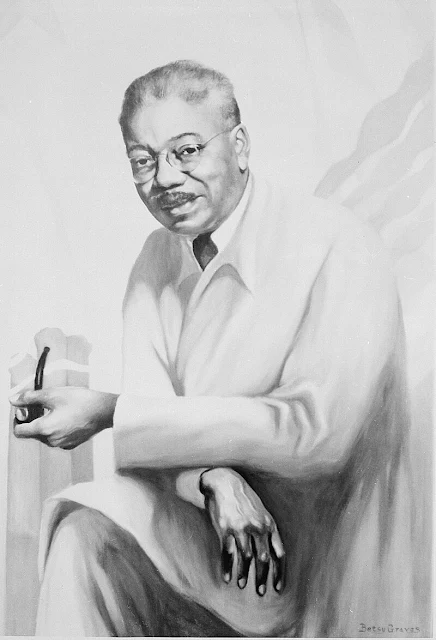Illuminating Cultural Identity: Aaron Douglas and the Visual Language of the Harlem Renaissance
The Harlem Renaissance, a cultural and artistic explosion that emerged in the early 20th century, was a period of profound transformation for African American identity and expression. At the heart of this vibrant movement stood Aaron Douglas, an artist whose work became emblematic of the era's aspirations and achievements. Known as the "father of African American art," Douglas's unique style and thematic focus played a crucial role in shaping the visual language of the Harlem Renaissance.
Early Life and Education
Aaron Douglas was born on May 26, 1899, in Topeka, Kansas. His upbringing in a relatively progressive community exposed him to a diverse array of influences from an early age. Raised in a family that valued education, Douglas's mother was a passionate amateur artist who encouraged his early interest in drawing and painting. His father, a baker by trade, also supported his son's artistic inclinations.
After completing high school, Douglas attended the University of Nebraska, where he earned a Bachelor of Fine Arts degree in 1922. His education provided him with a solid foundation in traditional art techniques, but it was his move to New York City in 1925 that would catalyze his transformation as an artist.
Arrival in Harlem
Douglas arrived in Harlem at a time when the neighborhood was burgeoning with intellectual and artistic energy. The Harlem Renaissance was in full swing, characterized by a flourishing of literature, music, theater, and visual arts. Influenced by the cultural dynamism around him, Douglas began to integrate African motifs and themes into his work, a departure from the more conventional styles he had previously explored.
He quickly became associated with prominent figures of the Renaissance, such as Alain Locke, Langston Hughes, and W.E.B. Du Bois, who encouraged him to explore and celebrate his African heritage through his art. This period marked the beginning of Douglas's distinctive style, which combined African iconography with modernist techniques.
A Unique Artistic Style
Douglas's art is characterized by its use of bold silhouettes, geometric shapes, and a limited but vibrant color palette. His work often features overlapping planes and radiating light, creating a sense of movement and depth. This style was not merely aesthetic; it was deeply symbolic, reflecting themes of African heritage, social progress, and racial pride.
One of Douglas's most celebrated series is the illustrations he created for Alain Locke's 1925 anthology "The New Negro," which is considered a seminal text of the Harlem Renaissance. These illustrations, with their stark contrasts and dynamic compositions, encapsulated the spirit of the Renaissance and set a new standard for African American art.
Notable Works
Several of Douglas's works stand out for their artistic and cultural significance:
1. Aspects of Negro Life (1934)
This mural series, commissioned by the Works Progress Administration (WPA) for the Harlem branch of the New York Public Library, is perhaps Douglas's most famous work. The series consists of four panels: "The Negro in an African Setting," "An Idyll of the Deep South," "From Slavery Through Reconstruction," and "Song of the Towers." Each panel traces the African American experience from Africa to contemporary America, depicting themes of oppression, resilience, and progress. The use of African-inspired aesthetics in conjunction with modernist techniques creates a powerful narrative that celebrates African American history and culture.
2. Song of the Towers
One of the panels in the "Aspects of Negro Life" series, "Song of the Towers," is particularly notable for its portrayal of the Great Migration. It depicts a towering figure holding a saxophone, symbolizing the cultural contributions of African Americans to American society. The industrial background and the Statue of Liberty in the distance underscore themes of aspiration and struggle for freedom.
3. Power Plant for Johnson Publishing Company (1944)
Douglas was also commissioned to create murals for various institutions, including the Johnson Publishing Company in Chicago. These works continued his exploration of African American history and culture, blending elements of African art with contemporary themes.
Influence and Legacy
Aaron Douglas's work had a profound impact on the Harlem Renaissance and beyond. His ability to merge African aesthetics with modernist principles created a new visual language that resonated with both African American and mainstream audiences. Douglas's art not only celebrated African heritage but also provided a powerful commentary on the social and political issues of his time.
Beyond his artistic contributions, Douglas was also an influential educator. He taught at Fisk University in Nashville, Tennessee, for nearly three decades, inspiring a new generation of African American artists. His commitment to education and his role in mentoring young artists further cemented his legacy as a pivotal figure in American art history.
Aaron Douglas's contribution to the Harlem Renaissance cannot be overstated. His unique blend of African motifs and modernist aesthetics helped define the visual identity of the era. Through his art, Douglas conveyed powerful narratives of African American history, culture, and identity, leaving an indelible mark on the art world. As we continue to explore the rich legacy of the Harlem Renaissance, Douglas's work remains a testament to the transformative power of art in shaping cultural and social consciousness.


.jpg)
.jpg)



.jpg)






.jpg)
No comments:
Post a Comment